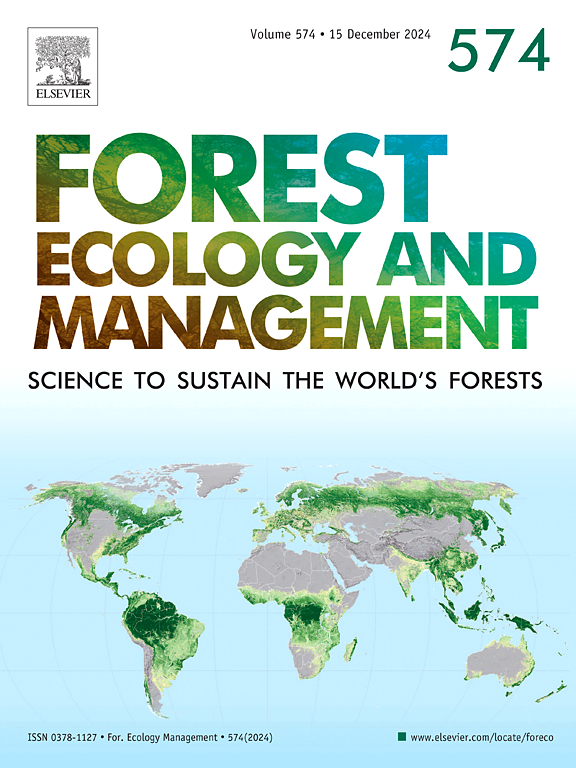在山地长叶松恢复过程中,林分结构、组成和火床的变化驱动着规定的用火行为
IF 3.7
2区 农林科学
Q1 FORESTRY
引用次数: 0
摘要
在美国中部和东部,由于数十年的禁火,依赖频繁用火(间隔 1-5 年)的稀树草原、林地和森林经历了广泛的生态状态转变。在没有火的情况下,中生植物(即耐阴、通常对火敏感和/或投机取巧的树种)蚕食中层,通过一个被称为 "中生化 "的过程,形成阴暗潮湿、易燃性低和生物多样性减少的林下空间。尽管通常使用规定火力来扭转中生化并恢复依赖火力的生态系统,但由于林分结构和组成的变化以及相关燃料的相互作用会影响易燃性,因此恢复过程中的火力行为仍然难以预测。为了更好地了解影响火灾行为的中生化机制,并确定火灾行为的关键预测因素,以利于土地管理者,我们评估了描述火灾强度(最高温度、蔓延速度和停留时间)和严重程度(燃料消耗)的指标与火灾前林木和落叶层组成和结构的关系。我们重点研究了山地长叶松(Pinus palustris Mill.(LLP)林分的恢复情况。通过贝叶斯路径分析,我们比较了林分或落叶组成和结构对火灾行为的影响。较低的林分基部面积和较高的松树、热解硬木(如高地柞树属)及相关落叶类型的相对重要性预计会增加火灾强度。结果表明,林分组成和结构对火灾行为有显著影响,但这并不是因为它们对落叶结构(负荷和体积密度)的影响。相反,枯落叶组成比枯落叶结构更能解释火灾行为。研究结果还表明,仅通过简单测量林分组成和结构就能预测火灾行为,这为评估面临中层化威胁的火灾依赖生态系统的恢复潜力提供了一种潜在的有用工具。本文章由计算机程序翻译,如有差异,请以英文原文为准。
Variations in stand structure, composition, and fuelbeds drive prescribed fire behavior during mountain longleaf pine restoration
Across the central and eastern U.S., frequent-fire (∼ 1–5 year interval) dependent savannas, woodlands, and forests have experienced widespread ecological state shifts due to decades of fire exclusion. Without fire, mesophytes (i.e., shade-tolerant, often fire-sensitive and/or opportunistic tree species) are encroaching in the midstory, creating shady, moist understories with low flammability and reduced biodiversity through a process known as “mesophication.” Although prescribed fire is commonly used to reverse mesophication and restore fire-dependent ecosystems, fire behavior during restoration remains difficult to predict because variations in stand structure and composition and associated fuels interact to influence flammability. To better understand the mesophication mechanisms influencing fire behavior and to identify key predictors of fire behavior for the benefit of land managers, we assessed how metrics that describe fire intensity (maximum temperature, rate of spread, and residence time) and severity (fuel consumption) relate to pre-fire stand and leaf litter composition and structure. We focused on the restoration of remnant mountain longleaf pine (Pinus palustris Mill. (LLP)) stands during the dormant prescribed fire season in the Georgia Piedmont region, USA. Using Bayesian path analysis, we compared the effects of either stand or leaf litter composition and structure on fire behavior. Lower stand basal area and higher relative importance of pine and pyrophytic hardwoods (e.g., upland Quercus spp.) and associated leaf litter types were expected to increase fire intensity. Results showed that stand composition and structure significantly influenced fire behavior, but not because of their influence on litter structure (load and bulk density). Rather, leaf litter composition may better explain fire behavior than leaf litter structure. Results also suggest that simple measures of stand composition and structure alone can be used to predict fire behavior, providing a potentially useful tool for assessing restoration potential of fire-dependent ecosystems under threat of mesophication.
求助全文
通过发布文献求助,成功后即可免费获取论文全文。
去求助
来源期刊

Forest Ecology and Management
农林科学-林学
CiteScore
7.50
自引率
10.80%
发文量
665
审稿时长
39 days
期刊介绍:
Forest Ecology and Management publishes scientific articles linking forest ecology with forest management, focusing on the application of biological, ecological and social knowledge to the management and conservation of plantations and natural forests. The scope of the journal includes all forest ecosystems of the world.
A peer-review process ensures the quality and international interest of the manuscripts accepted for publication. The journal encourages communication between scientists in disparate fields who share a common interest in ecology and forest management, bridging the gap between research workers and forest managers.
We encourage submission of papers that will have the strongest interest and value to the Journal''s international readership. Some key features of papers with strong interest include:
1. Clear connections between the ecology and management of forests;
2. Novel ideas or approaches to important challenges in forest ecology and management;
3. Studies that address a population of interest beyond the scale of single research sites, Three key points in the design of forest experiments, Forest Ecology and Management 255 (2008) 2022-2023);
4. Review Articles on timely, important topics. Authors are welcome to contact one of the editors to discuss the suitability of a potential review manuscript.
The Journal encourages proposals for special issues examining important areas of forest ecology and management. Potential guest editors should contact any of the Editors to begin discussions about topics, potential papers, and other details.
 求助内容:
求助内容: 应助结果提醒方式:
应助结果提醒方式:


